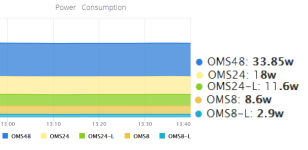Legacy Open Mesh: How Many Access Points Can My Switch Power?
Question
How many access points can my switch power?
Environment
- Datto access points
- Datto switches
Answer
To answer the question of how many PoE powered devices you can support on a single PoE switch, you need to first consider how much power your PoE devices need, and how much power your switch can provide.
Client devices today usually support standards based 802.3af or 802.3at PoE power. This means that they can request and draw up to a maximum of 15.4W (af) or 25.5W (at) from the switch port they are connected to.
For PoE switches you should look for their "PoE Budget" or "Power Dedicated to PoE" value, which is the total amount of power it has available to divide between PoE devices connected to it.
For example, if you have a switch with a PoE Budget of 45W, and two PoE devices that use the 802.3af standard (max 15.4W), then even if both devices draw their maximum allowed power (15.4 x 2 = 30.8W), there will still be plenty of spare power in the switches PoE budget.
Now let's take the example a step further. While the two PoE devices use the 802.3af standard, that only defines what the maximum power values are that the device can draw, not the actual amount of power the device will draw. If the device in fact only draws 5W of power during normal operation, then the scenario becomes (5W x 2 = 10W total PoE power draw) much less demanding on the AP, leaving the majority (10W - 45W = 35W) of it's PoE budget available. Information on both the PoE standard used and the normal/expected PoE power draw of your device should be available in the device manufacturer's technical detail pages or data sheets.
A word of caution when planning how many devices to run on one switch. As mentioned above, a device may only draw 5W of power during normal operation, however, that same device may still draw up to it's PoE type maximum (15.W/25.5W) at any time. This possibility can often be seen during times of high activity, such as boot up cycles when first connected or when the device resets. If you plan for your devices to only use 5W and install 10 on a switch with a 55W PoE budget, you may find that only a few of the devices are able to boot back up properly if the switch itself ever loses power, reboots, or other event where all the PoE devices try to power back on at the same time.
Next let's talk about what happens if you find yourself in a situation where the switches PoE budget is maxed out. This can vary based on the manufacturer of your PoE switch and the configuration applied to it. For OpenMesh switches, PoE power is provided on a priority basis (Low/Medium/High/Critical). This means that if, for example, you have a switch with a 45W PoE budget and 4 PoE client devices that use 15W each all set with a different priority, the device set with a "Low" priority will have it's PoE power re-allocated to supply the device with higher priority. This allows you to ensure that certain devices will never lose power or will always have enough power, even if the switch has already expended it's entire PoE budget.
One last thing to consider is that power draw on a PoE device can fluctuate. The power needed during initial boot-up compared to when the device is idle will often be significantly different. If the manufacturer data sheets do not state a max power draw value for your device, it's generally recommended to assume the device will draw its maximum allowed power during initial boot.
Open Mesh Device PoE Data
Switches:
Switch Idle Power Use by Model
POE Budget by Model
|
Model: |
Number of PoE ports: |
PoE Budget: |
|
S8-L |
8 |
55W |
|
S8 |
8 |
150W |
|
S24-L |
24 |
250W |
|
S24 |
24 |
370W |
|
S48 |
48 |
740W |
*All OpenMesh switches support 802.3af & 802.3at PoE standards only
Access Points:
|
Model: |
PoE type: |
Avg Idle/Normal/Max Draw: |
|
OM2P |
Passive PoE Only* |
4W/7W/10W |
|
OM2P-HS |
Passive & 802.3af |
4W/7W/10W |
|
OM5P-AC |
Passive & 802.3af |
4W/7W/11W |
|
MR1750 |
802.3af & 802.3at |
5W/10W/15W |
|
A40 |
802.3af & 802.3at |
5W/10W/15W |
|
A60 |
802.3af & 802.3at |
5W/10W/15W |
*Passive PoE powered devices require dedicated external PoE injectors and cannot be powered with OpenMesh PoE switches



